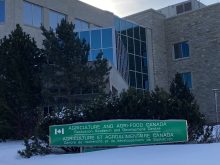There are opportunities in Europe for Canadian agriculture and food products, but we have to learn to play their game.
I recently spent a couple weeks in Europe visiting relatives and travelling with family.
In Great Britain, the cradle of the local food movement I noticed that the need to label everything as British is pervasive.
I checked a can of baked beans that said it was processed in Britain. There’s a good chance that the white beans inside came from Canada because the country supplies more than half of the white beans used for baked beans in Britain.
Read Also

High prices see cow-calf producers rushing to incorporate
Farm accountants are reporting a steady stream of cow-calf producers rushing to get their operations incorporated ahead of selling their calves this fall.
It represents the old and traditional way of doing business in Canada — selling undifferentiated commodities.
But in Britain, value-added gets the sales and the exposure, and indeed the same is true in most of Europe.
That’s where Canadian agriculture and food exporters have to go — to finished products that are of value to the market, not just unprocessed products.
Look at the results since CETA, the free trade agreement with the European Union, implemented in 2018. Canada has increased its pork and beef exports by more than 100 percent, but that is a 100 percent increase of very little before the agreement. Conversely, the EU has grown its exports of mostly processed products to Canada.
EU food exports to Canada increased by almost 10 percent, while Canada’s exports to the EU declined.
Until we are able to send high quality, less expensive finished products into Europe, that trade deficit will be a challenge.
It’s frustrating that Europe seems to always find ways to not buy our undifferentiated products through non-tariff barriers, but it shows why we must create better differentiated products.
Take the prepared meat counters in Canada versus the EU. Here, there’s little differentiation other than company and price.
In a Waitrose in Britain, the meat for slicing is labelled British first, then it also contains the other popular labels — the “free-from” labels and “organic” labels.
At one end of the counter is all the British meat — and it’s all differentiated beyond just British. At the other end is meat from other places, most of it undifferentiated, but a whole lot less expensive.
You can see a similar trend in the fresh fruits and vegetable area, with premium, and not always great quality fruits and vegetables from British farmers given precedence.
What struck me is there’s little middle ground. You’re either British or you’re bulk and undifferentiated (also affordable).
It makes sense to me that there’s room in the middle for a differentiated, high quality, decently priced group of products from a country that still sits well with the British — Canada, of course.
Canada doesn’t have the mystical cache in the U.K. that it does in Japan, China and other eastern countries. The crisp, clean and beautiful country that we sell in the Far East won’t fly in the United Kingdom.
However, it would be a good place to try out the mature, strong Canada Brand that everyone in export marketing has been talking about for at least a decade.
Another question is which Canadian companies can fill the market with differentiated products? Unfortunately, that’s the other thing keeping us from taking more advantage of the EU market.
We have some strong meat-processing companies that already do this well in the Far East. But, beyond Canadian meat companies, our food processors are focused on the U.S. and many do well there. Many lack the economic heft to make a pivot toward Europe, although it’s badly needed and quite possible.
John Greig is editor of Farmtario.
















